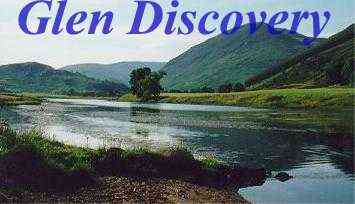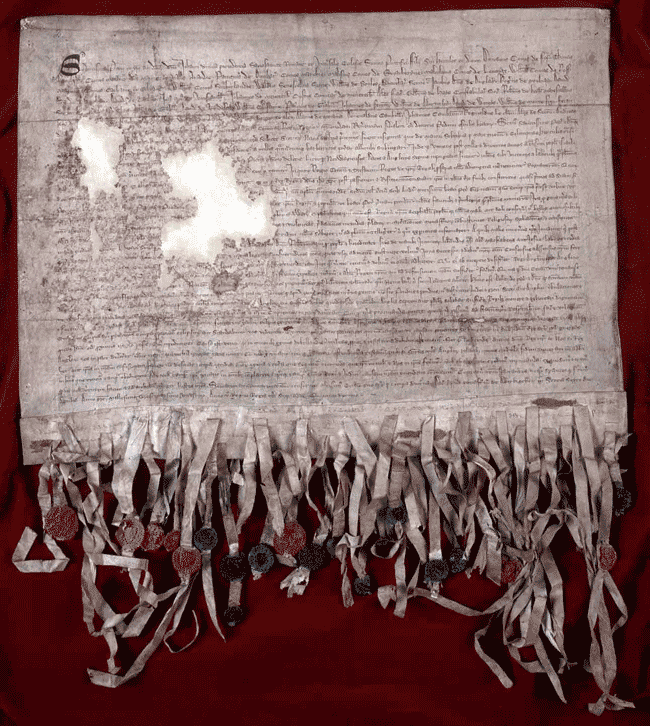
 |
The Declaration of ArbroathView the video of the Declaration of Arbroath on YouTube |
|
This year, 2020, marks the 700th anniversary of the letter to Pope John XXII in Avignon which has since become known as the Declaration of Arbroath. The Declaration is Scotland’s most iconic document and a treasure preserved by the National Records of Scotland. It is one of the most significant documents, marked by learning and scholarship, that emerged from Mediaeval Europe. It changed constitutional thinking – such that our King was required to rule in the best interests of his people who, through the Declaration, had the right to depose their ruler and choose another. This fundamental principle in constitutional law of the power of the people remains even to today and applies in all democratic states to Monarch and State Leader alike. Dr Murray Pittock discusses in this video the long-lasting significance of the Declaration of Arbroath today, both for Scotland and the World. A major commemoration in Arbroath had been planned for the weekend of 4th and 5th April 2020 leading up to the actual date of 6th April, which was intended to bring together people from all over Scotland and beyond. Sadly the event has been cancelled due to the Covid-19 pandemic. Scots broadcaster Lesley Riddoch and producer Charlie Stuart have produced a film at short notice which is available to view on YouTube here : The Declaration of Arbroath The film is not associated with or endorsed by any political party. According to Charlie Stuart, “We’re making this as Scots who treasure our heritage, history and character and will not let this important moment go unrecognised.” The film includes interviews with historians Fiona Watson, Tom Turpie and Billy Kay who discuss the significance of the document and the meaning of the text. There are scenes of Arbroath Abbey as it is today with indoor narrative filmed in Bannockburn House. There are glimpses of the surviving medieval document in the National Library of Scotland. A commemorative tapestry has been painstakingly and beautifully sewn during the past two years by the "Red Lichties", an Arbroath ladies group, and has now been mounted as a triptych in a bespoke frame by an Aberfeldy craftsman. Members of the Scottish public have contributed lines from the Declaration recorded on their phones and brought together through a Facebook page. The film begins with the most famous of the words from the Declaration, recorded by Scots actor Brian Cox, whose lines were sent from his phone in deepest New York State. The project was made possible by funding from lottery millionaire, Chris Weir. The Scots-born, Oscar nominated film composer Patrick Doyle has produced a fabulous original score. |
 |
On April 6, 1320 a letter was written to the Pope by Abbot Bernard de Linton from the scriptorium of Arbroath Abbey. The letter, on behalf of the Community of the Realm of Scotland was sealed by eight earls and about forty barons. The letter was intended to persuade the Pope of the legitimacy of King Robert's reign over Scotland and, more importantly, the right of the people of Scotland to choose their own ruler despite any claim to the contrary by the Kings of England. The Scots had defied papal efforts to broker a truce - since the papacy had explicitly supported the overlordship of the English crown over Scotland - in the long war with England. Following the recovery by the Scots of the town of Berwick in 1318, the Pope had again excommunicated King Robert and some of his barons. The letter to the Pope formed part of the Scots diplomatic counter-offensive. In response, the Pope wrote to Edward II urging him to make peace, but it was not until the Treaty of Northampton in 1328 that Scotland's independence was finally and grudgingly acknowledged by the English Crown. A printed translation from the Latin of the letter was made and published in Scotland near the end of the 17th century. The letter was reprinted many times during the 18th century in Scotland and beyond. Thus, the Declaration of Arbroath is not just a piece of ancient history. It inspired the Scots "Claim of Right" at the Revolution settlement of 1689 which placed boundaries on the powers of the monarchy, and asserted the right of appeal against injustice. The "Declaration of Arbroath" and the "Claim of Right" have become the constitutional basis of the concept of the "sovereignty of the people of Scotland", as opposed to the English view of the absolute sovereignty of Parliament. In 1989, a modernised Claim of Right was the founding document of the Scottish Constitutional Convention. The Claim of Right was adopted by the Scottish Parliament in 2012. On the 6th September 2016, Patrick Grady, MP. proposed a motion in the House of Commons re-asserting the Scottish Claim of Right. He said "my argument is that the Claim of Right is not, or is no longer, an historical document. It is a concept, and indeed a fundamental principle, that underpins the democracy and constitutional framework of Scotland. It is as relevant today as it has ever been". The motion was adopted without a division. I am grateful to John Bellassai for highlighting the parallels with 1776, when the principles of the Declaration of Arbroath became the basis of the American Declaration of Independence. Thomas Jefferson was himself a descendant of Thomas Randolph, Earl of Moray, a nephew of King Robert I and a signatory of the Arbroath letter. Jefferson's great friend and mentor was William Small, professor of rhetoric at the University of William & Mary in Virginia. Small, who had been born in Scotland in 1734, had a prominent role in the drafting of the Declaration of Independence. The 2020 Tartan Day events in America have also, sadly, been cancelled due to Covid-19. The date of Tartan Day was specifically chosen to commemorate the writing of the letter which has become known as the Declaration of Arbroath on 6th April 1320. [US Senate Resolution 155 of 10 November 1997 stated that the Declaration of Arbroath, the Scottish Declaration of Independence [sic], was signed on 6 April 1320 and the American Declaration of Independence was modelled on that inspirational document ] Jefferson offered a series of five propositions in the Declaration of Independence: (1) that all men are created equal; (2) that they are endowed by their Creator with certain inalienable rights; (3) that among these are life, liberty and the pursuit of happiness; (4) that to secure these rights, governments are instituted among men; and (5) that when any form of government becomes destructive of these ends, it is the right of the people to alter or abolish it. It contains this very Scottish idea - the so-called “self-evident” premise that when a government becomes tyrannical, the people have a right to rebel against it. Both documents contains a list of grievances against the tyrannical actions of a ruler as justification for the taking up of arms. The Declaration of Arbroath argued that it was the right of the people of Scotland to throw off the yoke of Edward II and to choose their own king; its counterpart in 1776 claimed that the American colonists had the right to reject George III and create a new form of republican government for themselves. Both documents stated that if the new government does not meet the peoples’ expectations, they may change it, yet again. Finally, there is something more important, a more universal sentiment, at work here, which at its heart makes the strongest connection between 1320, 1776 and the present day. In spirit, if not in form, both documents emphasize "freedom" - that most cherished of all ‘inalienable’ human rights: “We fight not for glory nor for wealth nor honour, but for that freedom which no good man surrenders but with his life”. Professor G.W.S. Barrow pointed out that these world-famous words were taken by Bernard de Linton from the writings of the Roman author, Sallust 6. "When the rule of the kings, which at first had tended to preserve freedom and advance the state, had degenerated into a lawless tyranny, they altered their form of government" 33. "But we ask neither for power nor for riches, the usual causes of wars and strife among mortals, but only for freedom, which no true man gives up except with his life." Extracts from "The War With Catiline" by Sallust (86–35 BC). published in the Loeb Classical Library, 1921 (revised 1931)
|